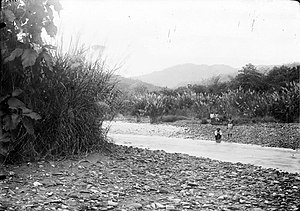Kayeli people

Kayeli men at the Lumaiti riverbank in Buru, 1892.
|
|
| Total population | |
|---|---|
| (800) | |
| Regions with significant populations | |
| Buru | |
| Languages | |
| Kayeli language, Indonesian language | |
| Religion | |
| Islam | |
| Related ethnic groups | |
| Buru people, Ambelay people, Lisela people |
Kayeli (Indonesian: Suku Kayeli) people is an ethnic group mainly living on the southern coast of the Kayeli Bay of Indonesian island Buru. From an ethnographic point of view, Kayeli are close to other indigenous people of Buru, such as Lisela and Buru. There were about 800 Kayeli people in the early 2000s. By religion, most Kayeli are Sunni Muslims, with some remnants of pagan beliefs.
Ethnogenesis of Kayeli is directly associated with the colonization of the Buru island by the Dutch East India Company in the 17th century. In 1658, the first permanent Dutch settlement and a military fort were built at the southern coast of Kayeli Bay, and for two centuries it was the administrative center of the island. Accordingly, thousands of indigenous people were forcibly relocated to this area from other parts of the island, including much of the tribal nobility, and about thirteen large villages had been built around the fort. The relocation was designed to facilitate control over the local population and provide workforce for clove fields which were being planted by the Dutch in this part of the island. Kayeli ethnicity with its own language was formed as a mixture of the newly arriving settlers and the native population of the fort area. The presence among the ancestors of the tribal aristocracy and interaction with the Dutch colonial administration resulted in a special position of Kayeli over the next centuries, who claimed the role of indigenous elite of the island.
Upon gradual softening of the colonial system, many tribes which were moved to Kayeli Bay started returning to their ancestral homes. So in 1880s, the leaders (rajas) of Leliali, Wae Sama and Fogi moved back a significant part of their ethnic groups; they were joined in the early 1900s by Tagalisa. So the Muslim (indigenous) population of Kayeli fort decreased from 1,400 in the 1850s to 231 in 1907. The decay was accelerated by the departure of the Dutch in the 1950s and formation of independent Indonesia. The fort was abandoned and most Kayeli people were assimilated by other tribes. Whereas a small Kayeli community still remains at Kayeli Bay, their language is likely lost.
...
Wikipedia
